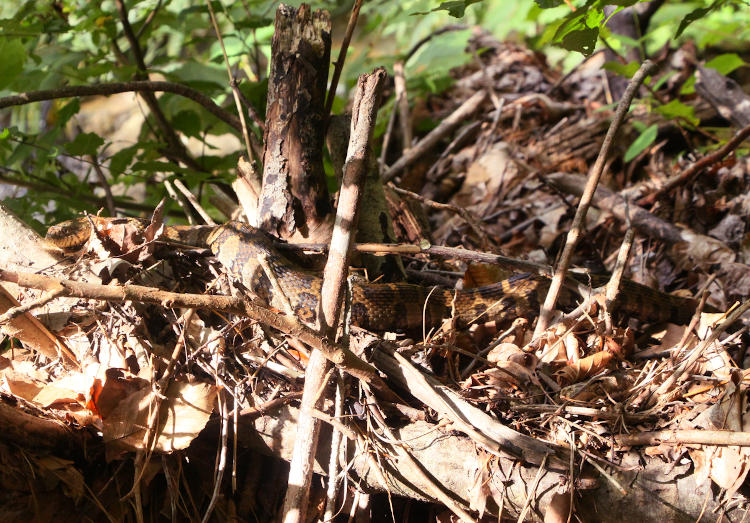This week we have another variation of the topic, as we see visibly different examples of a photo subject from just this past weekend, quite possibly the largest extremes that I have encountered locally – certainly the largest in a single day. We’ll start small.

I initially took this to be a juvenile ringnecked snake, but on examining the photos after returning, I was suspicious of those markings and looked it up; it is instead the juvenile coloration of a brown snake, sometimes called Dekay’s brown snake (Storeria dekayi.) The pale neck markings will fade as it gets older, but the darker markings adjacent will remain. In North America, you can be sure ‘brown snake’ means this little spud (though the average adult is much bigger while not at all ‘big,’) but most references to ‘brown snakes’ will be for the Australian species of the same common name – much bigger and infinitely more venomous, since this guy has none at all while the Australian one proves fatal a bit too often. And yes, this is my own palm. This is the second one we (Mr Bugg and I) found while on this outing, of the same general size but significantly separated in location, so probably not siblings. Overall length: no more than 12cm. Weight: I have no way of determining usefully, but in the realm of two leaves. Seriously. The empty film cans that I carry weigh more.
Which brings us to the other end.

Unfortunately, its location didn’t allow for ideal photographic views, so you have to look close, but the snake spans across the frame here – spot the scale pattern right in the center and then trace it both ways. This is a northern water snake (Nerodia sipedon sipedon,) and an absolute unit, as the phrase goes – possibly the largest that I’ve seen. Water snakes tend to be shorter but thick and stocky, so the length I’m estimating as close to a meter, while the girth was on a par with my wrist in the midsection. I can only guesstimate the weight from experience, since I didn’t pick this one up, but over a kilogram – more than any individual camera body or lens that I carry, save for the big 150-600mm. While the black rat snakes in the area tend to be longer, these guys mass much more. Let’s have a peek at the head.

For comparison, see my fingers in the top photo? This guy’s head was wider than two of them. It did, in fact, seem unnaturally ‘jowly’ and I don’t know what that was about – maybe a case of the mumps. This was as close as I got before the snake decided discretion was in order and slipped quickly (and amazingly quietly for its size) into the water.
The main goal of this session was snakes, but they were a bit slow in appearing, possibly because the recent rains had caused a lot of flooding in the immediate area – the evidence of the high water levels was plainly visible. Nonetheless, we did find a few other examples of the species, none of them basking.

Moving slowly allowed me this perspective, since the snake was obviously alert, but I had to go head-on if I could. I have to say that while it’s possible this is another species of water snake found in the area, since the primary way to tell them apart is by seeing the pattern further along the body (that would be the banded water snake,) I’m going to stick with the northern because that’s the most common and the only one that I’ve seen in this location, being New Hope Creek through Duke Forest. This is what my initial view was, though:

This is perhaps the most common way to find the species, since they like to hide and hunt under the submerged portions of rocks, but it is perhaps not the most common way that they’re seen – this is pretty subtle, so I suspect the ‘average’ person (i.e., someone not specifically hunting for snakes) tends to see the species only when they’re basking in a more visible location.
I have to note the difference in behavior among various species. Black rat snakes are longer, and easier to spot because they’re a uniform semi-gloss black on the back, often stretched across a path or occasionally in trees. Yet they’re remarkably docile, often able to be handled without a bite, and they’re not especially shy – they may seek cover quickly, slowly, or not at all. Meanwhile, the heavier water snakes blend in a hundred times better but are notably shy, seeking cover quickly as soon as they determine that camouflage isn’t working, yet they’re also the most aggressive snake in the area and will bite fiercely with any attempt at handling. I have no idea why this difference exists.
One more, because what else am I going to do with this photo?

Less than 1/4 the mass of the first monster, this one was poking from the water only by about 8cm, and roughly 2 in width of the head – pretty subtle from an average viewing distance. But if you’re after snakes, it’s what you have to look for.




















































